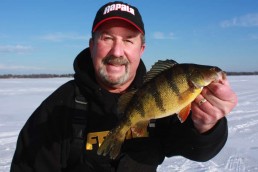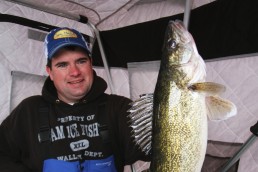Be Careful Fishing Late-winter Ice
SHARE THIS POST
We see it every winter. Somber news that a person has fallen through the ice and has become another fatality. It is a grim reminder that there is an inherent danger to venturing out on the ice of ponds and lakes, especially late in the winter. People seem to be more leery about a body of water that has relatively new ice, as compared to a body of water that has had existing ice for a considerable period of time. Remember this important fact: old ice is dangerous ice. At the beginning of winter, ponds and lakes are turning into ice. At the end of winter, ponds and lakes have begun the process of losing their ice.
In reality, there is always an element of danger with ice, and there’s no such thing as 100 percent-safe ice. Everyone that ventures out onto the ice should realize this and that includes ice fishermen, snowmobilers, winter hikers, and cross country skiers. Before anyone goes onto a frozen body of water, they should always check with a reliable source about the thickness and safety of the ice. Going onto ice should never be a solitary activity. Just as important, never assume that ice is safe because there are other people on the ice. These other people may be in a potentially dangerous situation and you do not want to join them.
Everyone who goes on the ice should always carry life-saving equipment. This includes ice picks that are preferably attached to a cord that is connected to you. If a person breaks though the ice, these picks are used to jab into the ice, to give a person the ability to help pull themselves out of the water. At least 50 feet of strong rope should be in everyone’s coat pocket. This rope can be thrown to someone who is in the water, so they can be pulled out. Wearing a personal floatation device is a superb idea. The modern PFD versions are lightweight and will keep a person afloat if they end up in the water after breaking through the ice. If a person falls into ice-cold water, action must be taken swiftly to get that person out of the water. Hypothermic shock will occur rapidly and the end result will be bleak.
Late winter is a period of rapid transition for ice. The sun is higher in the sky and the frozen body of water is getting more exposure to the warming rays of the sun. In turn, air temperatures are rising daily and there will be days when the air temperature is above freezing. Storm events can bring rain and this nonfreezing water on top of ice will further add to the progression of decomposition. Once the adjoining shoreline loses any cover of snow, the sun’s warmth will be accelerated by the dark bare ground and rocks that will effectively act as heat retainers. This will contribute in causing the areas that are nearest to the shoreline to lose the ice first. If the pond or lake has a tributary that enters it, the inflowing water will be warmer and this will also cause the surrounding area near the tributary to have thinning ice.
Unfortunately, there is no set date when the ice on a body of water will become unsafe. Different conditions of temperatures each winter will always cause a different scenario as to when that date of potential danger may be. At the beginning of the ice-making season, there are set standards that help apply a suspected safety condition of the ice. Four inches is generally considered safe ice to hold an ice fishing angler. Five to six inches is considered to be safe ice to support a group of ice fishing anglers that are in relatively close proximity to each other. Ten to 12 inches of ice is thought to be enough ice to support a snowmobile and over 12 inches of ice is generally considered strong enough to support a light vehicle.
Are you enjoying this post?
You can be among the first to get the latest info on where to go, what to use and how to use it!
In the late winter season, these set standards of ice safety do not apply, since we are now into a period of degrading ice. Degrading ice can have a different appearance. Unlike the clear ice during the beginning of the winter, late winter ice will be darker in color. This darkened color will cause more sunlight to be adsorbed, further downgrading the strength of the ice. Water on top of the ice will create a honeycomb appearance on the ice, causing it to be dramatically weakened.
The sad truth is that unsafe late-winter ice is often determined by a person who has decided to linger on the ice for too long into the end of winter. A snowmobile, vehicle, ice shanty or sometimes a person will break through the weakened ice. Word of this is spread and the body of water is considered to have unsafe ice. The important thing is that you do not want to be the person that has the experience of breaking through the ice. Jeopardizing your personal safety is not worth it. Establish a safe cut off date before the ice is compromised by the end of winter warming conditions.
Having personally experienced breaking through the ice, I was rather shocked by how fast it happens. There is no warning. No sounds of ice cracking or shouts of danger. A group ice fishermen and I had just stepped off of the shoreline onto an ice-covered lake. As we went a distance of about 20 feet on the ice, we all broke though at the same moment and found ourselves waist deep in the water. Late winter conditions had weakened the ice near the shoreline. We were soaked and our day was over, so we headed home. The outcome could have be far worse if the water was deeper.
Venturing onto the ice is an enjoyable winter activity when safety and good sense is applied. Always remember to monitor conditions for personal safety. When it is time to put the equipment away for the winter, do so, instead of taking unnecessary risks by trying to stretch out the winter ice season. Stay safe.
MWO
SHARE THIS POST
Did you enjoy this post?
You can be among the first to get the latest info on where to go, what to use and how to use it!
John Murray
John Murray has a passion for the outdoors. A former professional fly tyer and fishing shop owner for more than a decade, John is a member of the NYS Outdoor Writers Association and is determined to share an acquired lifetime of knowledge to help everyone become proficient hunters and anglers.



